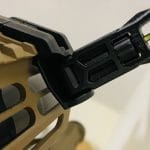


Free Shipping | 99% of all stands ship within 24 hours
We appreciate you sharing this:


We appreciate you sharing this:

Categories:
The comparison between 5.56×45 NATO and .308 Winchester (7.62×51 NATO) is one of the most significant caliber discussions in the world of modern rifles. These two cartridges define the performance expectations of the two most common rifle platforms used for training, duty use, marksmanship, and hunting: the AR-15 and the AR-10. Each caliber has a distinct ballistic signature, optimal engagement distance, recoil characteristic, and intended operational role. Selecting between them requires an understanding of how they perform under real-world conditions.
Originating from military adoption in the mid-20th century, 5.56 NATO was designed to provide a lightweight, lower-recoil solution that would enable controllable rapid fire and increased ammunition capacity per soldier. Paired with lightweight rifle platforms, the cartridge is optimized for engagements inside 500 yards and is widely used today in training, law enforcement, and civilian defensive applications.
.308 Winchester (and its military counterpart 7.62×51 NATO) predates 5.56 and is rooted in post-WWII platform evolution. Designed as a full-power rifle cartridge, .308 delivers significantly more energy and retains velocity at longer distances. It has remained a long-standing choice for precision shooters, big-game hunters, designated marksman roles, and professional applications requiring reliable performance out to and beyond 800–1,000 yards.
The performance contrast between the two cartridges is most clearly expressed in velocity, bullet weight, and retained energy at distance.
| Caliber | Typical Bullet Weight | Muzzle Velocity (fps) | Effective Engagement Range | Energy Level |
|---|---|---|---|---|
| 5.56 NATO | 55–77 grain | 2,700–3,200 fps | 0–500 yards | Moderate |
| .308 Winchester | 147–180+ grain | 2,500–2,800 fps | 0–1,000+ yards | High |
Summary: 5.56 is lighter, faster, and optimized for closer engagements. .308 is heavier, hits significantly harder, and maintains energy further downrange.
Recoil from 5.56 platforms is mild, making it easy to maintain accuracy during rapid strings of fire. This contributes to:
This is a primary reason 5.56 is preferred for high-volume training and duty environments requiring sustained accuracy.
.308 generates substantially more recoil, which directly affects shot cadence, sight recovery, and shooter fatigue. While trained shooters manage .308 recoil effectively, it remains less ideal for rapid engagements where time between shots is critical.
| Caliber | Standard Platform Type | Typical Magazine Capacity | Platform Weight |
|---|---|---|---|
| 5.56 NATO | AR-15 pattern | 30 rounds (standard) | Lightweight / agile |
| .308 Winchester | AR-10 pattern | 20 rounds (standard) | Heavier / more stable but less maneuverable |
The difference in platform size and total loaded weight becomes important in field carry situations where the user may be moving for extended periods. A loaded .308 platform with spare magazines adds noticeable weight compared to 5.56 systems.
5.56 excels in:
Its performance relies on velocity-driven fragmentation or controlled expansion; therefore, proper ammunition selection is essential.
.308 is preferred for roles requiring:
The energy delivered on target is significantly higher, making .308 ideal for long-distance marksmen and hunters who require reliable performance across variable terrain and animal size.
Both calibers perform effectively at these distances, though 5.56 holds advantages in recoil control, platform weight, and ammunition capacity.
.308 retains energy and external stability significantly better than 5.56, making it substantially more effective past the mid-range distance threshold.
| Category | 5.56 NATO | .308 Winchester |
|---|---|---|
| Recoil | Low / easy to control | High / requires discipline |
| Platform Weight | Lighter systems | Heavier systems |
| Effective Range | 0–500 yards | 0–1,000+ yards |
| Use Case | Training, home defense, rapid engagements | Long-range marksmen, hunting, designated outdoor roles |
Selecting between 5.56 NATO and .308 Winchester depends foremost on the intended application. For roles requiring speed, high round count, maneuverability, and sustained training capability, 5.56 is the practical and efficient choice.
For applications involving long-distance accuracy, variable outdoor environments, and scenarios requiring greater stopping potential, .308 Winchester offers capabilities that lighter intermediate calibers cannot match.
Ultimately, the best solution is determined by the environment, mission profile, and the level of training the user is prepared to maintain.
Always follow safe handling practices and all applicable laws.